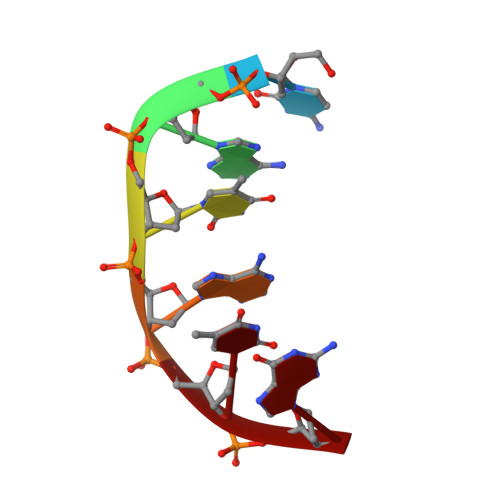Sequence-specific local structural variations in solution structures of d(CGXX'CG)2 and d(CAXX'TG)2 self-complementary deoxyribonucleic acids.
Lam, S.L., Au-Yeung, S.C.(1997) J Mol Biol 266: 745-760
- PubMed: 9102467
- DOI: https://doi.org/10.1006/jmbi.1996.0783
- Primary Citation of Related Structures:
1BUF, 1UQA, 1UQB, 1UQC, 1UQD, 1UQE, 1UQF, 1UQG - PubMed Abstract:
In this study, the solution structures of eight self-complementary deoxyribonucleic acid molecules, d(CGXX'CG)2 and d(CAXX'TG)2 (where X = C, G, T or A and X' is complementary to X), have been determined using NMR interproton distances, endocyclic sugar torsion angles, backbone torsion angles and hydrogen bond constraints. Based on the structural data obtained in solution, a novel sequence-specific local structure function, sigma LS, composed of the sum of the contributions from the helix twist omega, base roll rho, base-pair slide delta delta and propeller twist omega, is introduced to describe their sequence-specific local structures. Sigma LS is found to produce an acceptable correlation (r = 0.96) with the relative local stability (delta G0 10) of a base-pair-step. This result demonstrates that in addition to the inter-strand purine-purine clashes, the base morphology of nearest-neighbor base-pairs is also important in defining the local geometry of base-pairs. Thus, in analyzing the base-pair structural parameter blocks of trimers are used as the basic unit whereas for the base-pair-step structural parameters, the basic unit is composed of blocks of tetramers. The omega LS-delta G(zero) 10 correlation is the first experimental evidence demonstrating the relationship between the relative local stabilities and the sequence-specific local structures of DNA duplexes. It also forms the basis for using the trimer-tetramer model for the prediction of sequence-specific local structures of deoxyribonucleic acid molecules.
Organizational Affiliation:
Department of Chemistry, Chinese University of Hong Kong, Shatin, New Territories, Hong Kong.













